- Submissions

Full Text
Research in Pediatrics & Neonatology
A Comprehensive Review of Neu Laxova Syndrome
Shahin Asadi*, Sima Koohestani and Arezo Zare
Medical Genetics Director of the Division of Medical Genetics and Molecular Pathology Research, Division of Medical Genetics and Molecular Pathology Research, Center of Complex Disease, USA
*Corresponding author: Shahin Asadi, Medical Genetics Director of the Division of Medical Genetics and Molecular Pathology Research, Division of Medical Genetics and Molecular Pathology Research, Center of Complex Disease, USA
Submission: July 31, 2025; Published: August 19, 2025
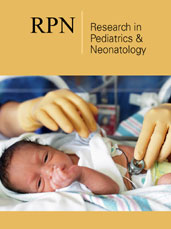
ISSN: 2577-9200 Volume8 Issue3
Abstract
Neu-Laxova Syndrome (NLS) is a rare genetic disorder that is inherited as an autosomal recessive trait. NLS is associated with distinctive prenatal abnormalities. These may include severe growth retardation (intrauterine growth retardation), excess fluid in the thin-walled membrane (amniotic sac) surrounding the fetus during pregnancy (polyhydramnios); abnormally reduced fetal movements; a short umbilical cord; and an abnormally small placenta (the placenta is an organ in the uterus that joins the blood supplies of the mother and the developing fetus). Babies with NLS usually have abnormally low birth weight and height, as well as a distinctly small head size (microcephaly). Additional abnormalities of the head and face (craniofacial region) are also usually present, resulting in a characteristic appearance. NLS is transmitted as an autosomal recessive trait. Human traits, including classic genetic diseases, are the product of the interaction of two genes, one inherited from the father and one from the mother. In recessive disorders, the disease does not appear unless the individual inherits the same defective gene for the same trait from each parent.
Keywords:Neu-Laxova Syndrome (NLS); Microcephaly; Craniofacial region; Idiopathic disease
Introduction
Neu-Laxova Syndrome (NLS) overview
Neu-Laxova Syndrome (NLS) is a rare genetic disorder that is inherited as an autosomal recessive trait. The syndrome is characterized by severe prenatal growth delays (intrauterine growth retardation), low birth weight and height; and distinctive abnormalities of the head and facial region (craniofacial region). These may include markedly small head size (microcephaly), sloping forehead, widely spaced eyes (ocular hypertelorism), and other abnormalities that result in a distinctive facial appearance. NLS is also commonly characterized by abnormal fluid accumulation in tissues throughout the body (generalized edema), permanent bending and immobility of multiple joints (flexion contractures), other limb abnormalities; and/or abnormalities of the brain, skin, genitals, kidneys, or heart [1].
Clinical signs and symptoms of Neo-Laxova Syndrome (NLS)
NLS is associated with distinctive prenatal abnormalities. These may include severe growth retardation (intrauterine growth retardation), excess fluid in the thin-walled membrane (amniotic sac) surrounding the fetus during pregnancy (polyhydramnios); abnormally reduced fetal movements; a short umbilical cord; and an abnormally small placenta (the placenta is an organ in the uterus that joins the blood supplies of the mother and the developing fetus). In addition, in some cases, the umbilical cord may have only two blood vessels (the umbilical cord, a flexible structure that connects the fetus to the placenta, typically has two umbilical arteries as well as one larger umbilical vein) [1]. Babies with NLS usually have abnormally low birth weight and height, as well as a distinctly small head size (microcephaly). Additional abnormalities of the head and face (craniofacial region) are also usually present, resulting in a characteristic appearance. Such abnormalities include a sloping forehead, a flat nose with a broad nasal bridge; full cheeks; and a small, underdeveloped jaw (micrognathia). Affected infants may also have large, poorly formed, and malformed (dysplastic) ears; a round, open mouth with thick lips; a short neck; and, more commonly, unusually prominent eyes. In addition, the eyelids are underdeveloped (hypoplastic) and turned outward (ectropion), making them appear absent. Additional eye (ocular) abnormalities may also be present, such as abnormally small eyes (microphthalmia) and loss of clarity of the lens of the eye (cataract). Some affected infants may also have incomplete closure of the roof of the mouth (cleft palate) and a vertical groove in the upper lip (cleft lip) [1] (Figure 1).
Figure 1:Images of a newborn with Neo-Laxova syndrome and related disorders.
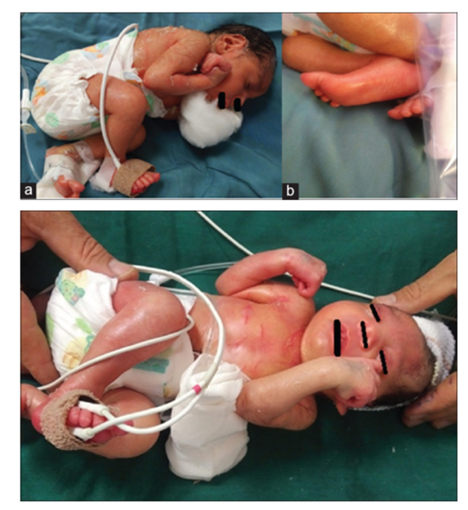
NLS is also associated with musculoskeletal abnormalities, including permanent bending and immobility of major joints (flexor contractures), such as the elbow, wrist, hip, knee, and ankle, along with skin tags at some immobile joints (such as the elbow and knee). In addition, the arms and legs are abnormally short, and the hands and feet may be swollen. Affected infants may also have overlapping toes; webbed or fused toes and feet (syndactyly); and a deformity in which the legs appear to be rocking in a rocking chair (rock foot). In addition, there may be bony prominences in the hands and feet and other abnormalities of bone formation (ossification refers to the conversion of fibrous tissue or cartilage to bone) [1,2] (Figure 2). The disorder is also usually characterized by an abnormal accumulation of fluid in tissues throughout the body (generalized edema). In addition, some infants may have an abnormal proliferation (i.e., myxomatous) of connective tissue or excessive fatty deposits beneath the outermost layer of skin (epidermis), along with degeneration (atrophy) of surrounding muscles. In rare cases, edema may be absent or may be limited to the scalp. Some affected infants may also have yellow, dry, scaly (“ichthyotic”) skin. NLS may also be associated with brain abnormalities. In many cases, the folds of the outer region of the brain (the cerebral cortex) develop incompletely, causing the surface of the brain to appear unusually smooth (agyri). Additional abnormalities may include the absence of the thick band of nerve fibers that connects the two hemispheres of the brain (agenesis of the corpus callosum) or underdevelopment (hypoplasia) of the cerebellum, an area of the brain that plays a key role in coordinating voluntary movements and maintaining proper posture. In addition, in some cases, there may be a cystic abnormality in the fourth ventricle of the brain (Dandy-Walker anomaly) and associated hydrocephalus. Hydrocephalus is a condition in which the flow or absorption of the fluid that circulates through the ventricles of the brain and spinal canal [Cerebrospinal Fluid (CSF)] is impaired, potentially leading to increased fluid pressure in the brain, rapid increase in size, or other related findings of the head. In some cases, NLS may be associated with additional abnormalities of the brain and spinal cord (central nervous system) [1,3].
Figure 2:Images of an infant with Neo-Lax syndrome along with associated disorders and a genetic pedigree for the syndrome.
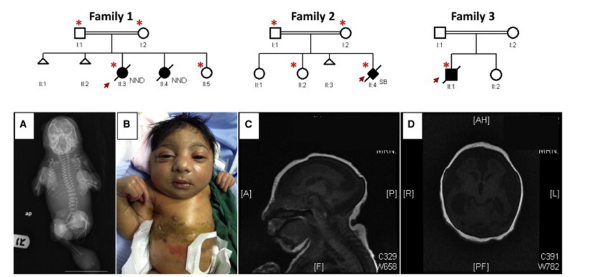
Some affected infants may have additional physical abnormalities, such as underdevelopment of the genitals, absence of one kidney (unilateral renal agenesis) or other kidney defects, underdevelopment of the lungs (pulmonary hypoplasia); or structural abnormalities of the heart (congenital heart defects). Congenital heart defects may include an abnormal opening in the fibrous partition (septum) that separates the upper or lower chambers of the heart (atrial or ventricular septal defect), a persistent opening in the fetus between the two main arteries (aorta, pulmonary artery) that leave the heart (patent ductus arteriosus), or a heart defect in which the aorta and pulmonary arteries are in their normal positions (transposition of the great arteries). Infants with NLS may be stillborn or develop life-threatening complications shortly after birth [1,3].
Etiology of Neo-Laxova Syndrome (NLS)
NLS is transmitted as an autosomal recessive trait. Human traits, including classic genetic diseases, are the product of the interaction of two genes, one inherited from the father and one from the mother. In recessive disorders, the disease does not appear unless the individual inherits the same defective gene for the same trait from each parent. If an individual inherits one normal gene and one gene for the disease, the individual will be a carrier of the disease but will usually not show symptoms. The risk of passing the disease on to children of a couple who are both carriers of the recessive disorder is 25%. 50% of their children are at risk of being carriers of the disease but generally do not show symptoms of the disorder. 25% of their children may inherit both normal genes, one from each parent, and be genetically normal (for that particular trait). The risk is the same for each pregnancy [1,4]. The parents of several individuals with NLS have been closely related by blood (familial). In recessive disorders, if both parents have the same gene for a disease trait, there is an increased risk that their children will inherit two genes necessary to cause the disease. There have also been a few cases reported in which NLS appears to occur randomly (sporadically) for unknown reasons [1,4] (Figure 3).
Figure 3:Images of dead fetuses with Neo-Laxova syndrome.
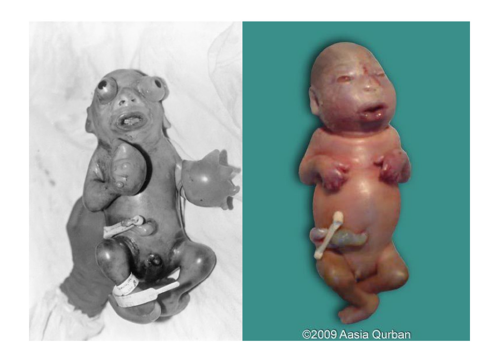
Frequency of Neo Laxua Syndrome (NLS)
NLS appears to affect men and women in a relatively equal number. Since the disorder was originally described in three siblings in 1971 (NeU, RL) as well as three siblings in another family in 1972 (Laxova, R), more than 30 have been reported. Researchers suggest that the disorder may be more common in Pakistanis than other geographical or ethnic populations [1,4] (Figure 4 & 5).
Figure 4:Another view of the disorders associated with Neo -Laxova syndrome.
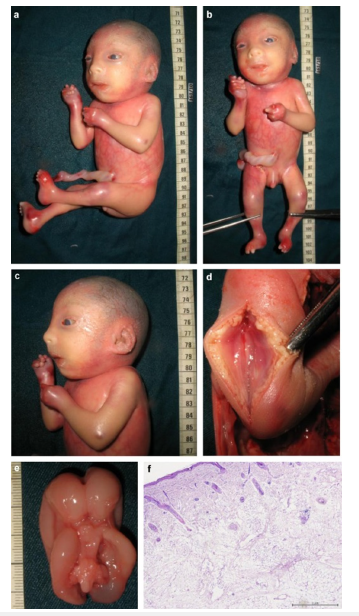
Figure 5:The schematic of the recessive autosomal inheritance pattern that Neo Laxova’s syndrome adheres to this pattern.
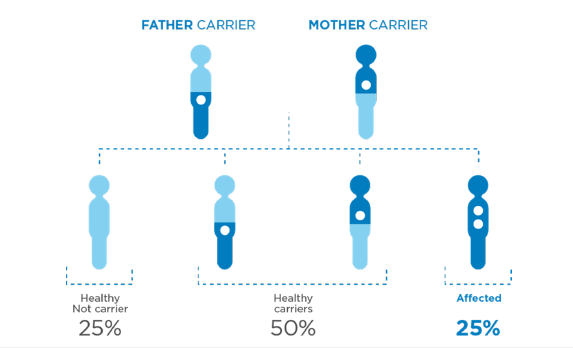
Diagnosis of Neo Laxua Syndrome (NLS)
NLS diagnosis may be recommended before birth (fetal) based on specialized experiments, such as recurrent fetal ultrasound. During fetal ultrasound, sound waves are used to create an image of a growing fetus. Such experiments may indicate characteristic findings that indicate NLS, such as poor fetal activity, limited body movement, excess fluid in the membrane bag around the growing embryo (polyhydraminius), small placenta, and intrauterine growth delays. The additional findings observed in ultrasound that may indicate NLS include the size of an abnormal head, backward forehead, prominent eyes, arthritis, or general abdomen [1,5] (Figure 6). NLS diagnosis may also be performed or approved after birth based on complete clinical evaluation and specified physical findings. Specialized tests may also be performed to identify specific conditions that may be potentially related to this disorder (for example, congenital heart failure) [1,5].
Figure 6:Radiology images of Neo Laxua syndrome disorders.
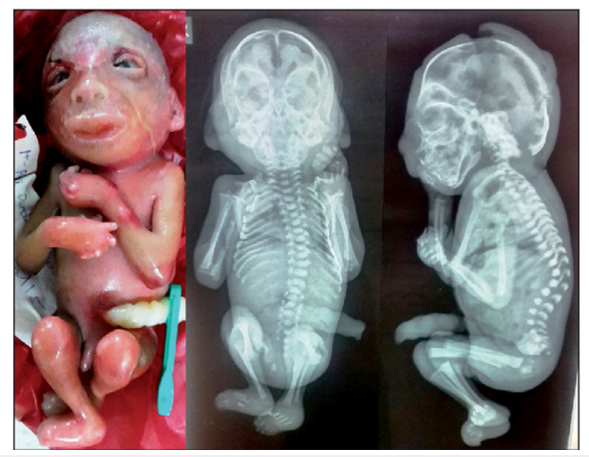
Treatment of Neo Laxua Syndrome (NLS)
The treatment of NLS is toward certain symptoms that are obvious in each person. Such a treatment may be coordinated by a team of medical specialists such as pediatrician who diagnose and treat neurological disorders (neurologists), physicians who diagnose and treat heart abnormalities (cardiologists); Or other health care professionals need. Special treatments for NLS treatment are symptomatic and supportive. In addition, genetic counseling will be useful for affected families [1,5].
Discussion
Babies with NLS usually have abnormally low birth weight and height, as well as a distinctly small head size (microcephaly). Additional abnormalities of the head and face (craniofacial region) are also usually present, resulting in a characteristic appearance. Such abnormalities include a sloping forehead, a flat nose with a broad nasal bridge; full cheeks; and a small, underdeveloped jaw (micrognathia). Affected infants may also have large, poorly formed, and malformed (dysplastic) ears; a round, open mouth with thick lips; a short neck; and, more commonly, unusually prominent eyes. The disorder is also usually characterized by an abnormal accumulation of fluid in tissues throughout the body (generalized edema). In addition, some infants may have an abnormal proliferation (i.e., myxomatous) of connective tissue or excessive fatty deposits beneath the outermost layer of skin (epidermis), along with degeneration (atrophy) of surrounding muscles. In rare cases, edema may be absent or may be limited to the scalp. Some affected infants may also have yellow, dry, scaly (“ichthyotic”) skin. NLS may also be associated with brain abnormalities. In many cases, the folds of the outer region of the brain (the cerebral cortex) develop incompletely, causing the surface of the brain to appear unusually smooth (agyri). Additional abnormalities may include the absence of the thick band of nerve fibers that connects the two hemispheres of the brain (agenesis of the corpus callosum) or underdevelopment (hypoplasia) of the cerebellum, an area of the brain that plays a key role in coordinating voluntary movements and maintaining proper posture [1-5]. Symptoms of the following disorders may be similar to NLS symptoms. Comparison may be useful for differential diagnosis: Cerebral-Choko-Facial-Susio- Syndrome (COFS) is a rare genetic disorder that is sometimes also known as Type II Pena Syndrome. Some researchers suggest that NLS and COFS syndrome may indicate a disease. (Other researchers have shown that COFS syndrome and another condition called Boont Haterite Syndrome may be the same disorder. COFS syndrome with severe and progressive postponement (post -birthday growth deficiency); Centrals have been able to add weight as expected, and they have a low -income cranial abnormalities. Large and low -lying ears also have narrow eyelids, unusual eyes (cataracts), or other musculoskeletal defects. Abnormalities from the front or side (kyphoo); And the progressive degeneration of the meal, a fatty substance around the particular nerve fibers that enables the infant and children it comes with this disorder [1-5]. Boon Herite Syndrome is a rare genetic disorder that has occurred mainly in the people of the intellect. This disorder is characterized by prenatal growth delays (intrauterine growth delays), lack of growth and weight gain to the expected level (growth in growth) during infancy, distinctive skull abnormalities, such as a small abnormal head (microcepanus), prominent nose, and small and underdeveloped jaw. Other physical abnormalities may include limited joint movements, abnormal (clinodacular) or permanent bending (campaignic) fifth fingers, flat feet or unprocessed testicles (cryptocidyism) in men. Some infants may also have kidney, brain, or other abnormalities. Boon Hutrit’s syndrome is inherited as an autosomal trait [1-5]. Embryical Akkini sequence, also known as Type I Pena Shocker Syndrome, with a lack of pre -growth (intrauterine growth delay), severe lung growth (pulmonary hyperoplasia) and respiratory problems (respiratory distress) at birth, permanent bending and multiplication of multiplication; And the anomalies of the skull are specified. Many researchers suggest that fetal aquinosis sequence does not indicate a specific syndrome or existence of the disease, but rather indicates the symptoms of characteristic and physical findings (conventional phenotypes) due to abnormal movement of fetal growth (hypochinosis or embryonic akin) and muscle weakness. Many of the causes of different backgrounds with embryonic akini sequel usually moderate arthritis contractions in the wrist, elbow, buttocks, knees and ankles in some irregular joints; Permanent bending (computitial) and abnormal deviation of special fingers to the “small finger” of the hand (ulnar deviation). Foot abnormalities (for example, brackets [talipes equinovarus] or rocker feet); Or other musculoskeletal abnormalities. Specificial anomalies of the face skull may include a high nose with a nasal tip, high -distance eyes (eye hypertlory); Faded and deformed ears; A small and collected abnormal jaw (micrretrognathia); Or incomplete closure of the roof of the mouth (cleft palate). Infants may have excess abnormalities such as short neck, genital abnormalities and genital abnormalities, heart defects or other malformations. The researchers suggest that embryonic akina sequence may be due to many neurological or neuromuscular disorders or other factors [1-5]. Dermopathy is a rare genetic disorder that is inherited as an autosomal trait. This disorder is associated with severe prenatal growth delay. Excess fluid in the thin wall membrane (amniotic bag) around the fetus The short cord of the short; And abnormal movements decrease during fetal growth. In addition, infants with regular, stretched and sticky skin, underdeveloped lungs (pulmonary hyperoplasia); Permanently curved and unnecessary joints (contractions); Rucker legs and other skeletal abnormalities. Babies also have the characteristics of skull and face, such as high -distance eyes (eye hypertlory), protruding eyelids (ectropion); Nose small and compact; The small and open mouth; And the jaws are not developed (Micrognathia). Infants may be born or have a life -threatening complication shortly after birth [1-5]. Trisomy 18 is a rare chromosomal disorder in which the entire or one critical area of chromosome is 18 times (trisomy) three times (mosaism) or all the cells of the body. Depending on the specific location, the repetition (trisomy) of the chromosome 18 as well as the percentage of cells containing abnormalities of symptoms and findings may vary from one case to another. However, before birth, the anomalies often include poor fetal activity, small placenta and excess fluid in the membrane bag surrounding the growing fetus (polyhydrinenius). After birth, characteristic findings include lack of growth, nutrition and respiratory problems, delayed growth, mental disability, and in infected men, unprocessed testicles (cryptocidy). People with trisomy 18 syndrome may also be distinctive of the face skull abnormalities, such as the size of the small head (microcephaly) which appear to be unusual long and narrow (Dolicochefali), the prominent back zone of the head (post -series); Small mouth (microstomy) and underdeveloped jaw (microgenathia); Incomplete closure of the roof of the mouth (cleft palate); An abnormal groove in the upper lip (cleft lip); Or have a nose upward. Infants may also have narrow eyelid folds, high distances (eye hypertlory), and upper eyelids (ptosis). The anomalies of the hands and feet are also often present, including the fingers on the toes and bent, the toes woven (syndrome); And the shape of the heels rotates inward and the soles of the feet are bent (the talipes Equinovarus]. Infants with trisomy 18 syndrome may also have a small pelvis with limited hip movements, short breasts (sternum), renal abnormalities, and structural defects of the heart that are present at birth. Such cardiac defects may include an abnormal opening in the partition of the lower heart cavities (ventricular septum defect) or the continuity of the fetus between the two main arteries (aortic, pulmonary artery) that comes out of the heart (open arterial canal) [1-5]. There are a number of other disorders that may be determined by abnormal movement during fetal growth. Delay in growth; Multiple articular contractions; The skin’s woven; Facial skull abnormalities, central nervous system, cardiac or renal abnormalities; Or other anomalies similar to cases that are potentially related to NLS [1-5].
References
- Asadi S (2025) Human idiopathic diseases books, Amidi Publications 4.
- Shreedhara Avabratha K (1999) Neu-Laxova syndrome. Indian Pediatr 36(3): 328.
- Hirota T (1998) A Japanese case of Neu-Laxova syndrome. J Dermatol 25(3): 163-166.
- (2011) Online Mendelian Inheritance in Man (OMIM). The Johns Hopkins University, Maryland.
- Kainer F (1996) Qualitative analysis of fetal movement patterns in the Neu Laxova syndrome. Prenat Diagn 16(7): 667-669.
© 2025 Shahin Asadi. This is an open access article distributed under the terms of the Creative Commons Attribution License , which permits unrestricted use, distribution, and build upon your work non-commercially.
 a Creative Commons Attribution 4.0 International License. Based on a work at www.crimsonpublishers.com.
Best viewed in
a Creative Commons Attribution 4.0 International License. Based on a work at www.crimsonpublishers.com.
Best viewed in 







.jpg)






























 Editorial Board Registrations
Editorial Board Registrations Submit your Article
Submit your Article Refer a Friend
Refer a Friend Advertise With Us
Advertise With Us
.jpg)






.jpg)














.bmp)
.jpg)
.png)
.jpg)










.jpg)






.png)

.png)



.png)






